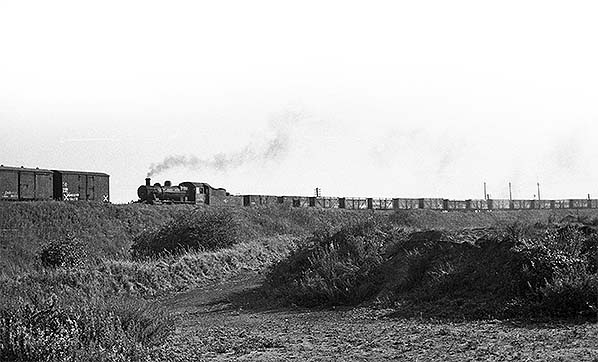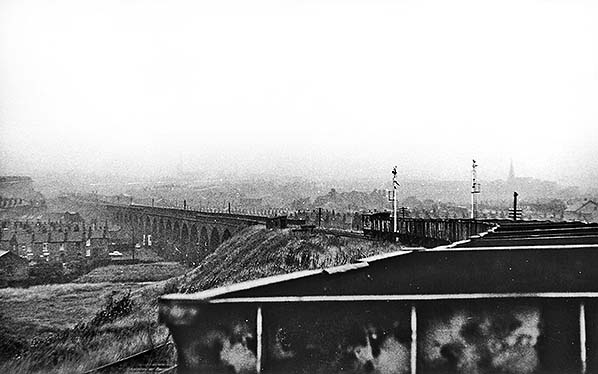
THE FACIT BRANCH: ROCHDALE TO BACUP ROCH VIADUCT - HEALEY DELL VIADUCT - SIAMESE BRIDGES ROCH VIADUCT (SD907138) Construction of the Roch Viaduct was no easy matter. One pier had to be dismantled and rebuilt twice and other piers also needed remedial work. There were also problems with the embankment at the north end of the viaduct as the spoil used in its construction, extracted from cuttings at Broadley, proved to be quicksand which turned into slurry, spreading in all directions when it was tipped from a height of 36ft, endangering the stability of the viaduct. At one stage when over 200 wagon-loads per day were being tipped the embankment failed to make any advance. The viaduct’s 18 arches were built of brick – the most common material of construction in Rochdale, while progressively up the Whitworth Valley stone takes over. The span of each arch was 37ft 4in apart from a skew span of 45ft across the river. The viaduct carried two tracks; the route narrowed to a single track about ¼-mile north of Wardleworth. The viaduct opened with the line in 1 October 1870 to goods traffic and to passengers a month later. It handled goods and passenger trains until the latter were suspended on 16 June 1947, and the line across it closed entirely on 21 August 1967; the tracks were lifted by the end of that year. Having proved troublesome to build, the viaduct was unexpectedly obliging when its demolition was in hand. On 11 July 1972 when contractors were conducting a test explosion on one single arch a chain reaction was set off, and 11 of the arches collapsed, blocking Entwisle Road and fracturing gas and water mains in the process.

Looking south-east at about 2pm on Tuesday 6 October 1959 as the down branch freight approaches Roch Viaduct. It is hauled by Ivatt-designed Class 2F 2-6-0 No.46406. The loco was built in December 1946 at BR Crewe works. She was withdrawn from 26A, Newton Heath shed, on 31 January 1967 and cut up by Cashmores, Newport, the following September.
Photo by Richard S Greenwood  Ivatt Class 2F 2-6-0 No.46406 is heading north-westwards across the 18 arches of the Roch Viaduct with the afternoon branch freight on Tuesday 6 October 1959. It looks as though the long train of wagons is being taken to Wardleworth goods yard, and that the engine and brake will then proceed to Shawclough & Healey; this was normal for the afternoon freight, which ran about 2pm. The loco was built in December 1946 at BR Crewe works. She was withdrawn from 26A, Newton Heath shed, on 31 January 1967 and cut up by Cashmores, Newport, the following September.
Photo by Richard S Greenwood 
On 28 July 1962 the Roch Valley Railway Society visited Facit during its ‘Salford Hundred Railtour’, hauled there by No.52523 and returning to Rochdale behind No.40063. In this view, looking north-west, the train is travelling from Rochdale towards Wardleworth and is approaching the Roch Viaduct. A signal cabin formerly stood between the sidings (seen left) and the viaduct.
Photo by Ian G Holt 
Looking north-east along Entwisle Road from the junction with Hovingham Street on 9 November 1964. A BR Sulzer Type 2 diesel is hauling the Newton Heath breakdown train northwards across the 18-arch Roch Viaduct to rescue an Ivatt Class 2 2-6-0 on the branch freight which had derailed at
Shawclough & Healey. Photo by Barry Hilton 
Looking north-east along Entwisle Road from the junction with Hovingham Street, the LCGB ‘Middleton Branch Brakevan Tour’ is crossing the Roch Viaduct on 7 August 1965. The train originally consisted of nine brake vans but on its ‘down’ journey it stalled on the 1 in 59/62 gradient north of Wardleworth, and the loco propelled its load back to Wardleworth where five of the vans were detached. The four remaining vans completed the journey to Whitworth and back to Wardleworth, where the train was re-formed to the full nine vans. The tour is seen in this photograph travelling from Wardleworth to Rochdale at the end of its visit to the branch. The loco, No.42343, a Fowler-designed Class 4P-D 2-6-4T was built at the LMS Derby works in April 1929 and allocated the number 2343. About two months after her journey to Whitworth she was withdrawn from 13A, Trafford Park shed, and cut up by Cashmores, Great Bridge, in November 1965.
 Looking north from a southbound mineral train on 18 August 1967, three days before the line between Rochdale and Whitworth closed to all traffic. The Roch Viaduct can be seen stretching away into the mist. Wardleworth station is a short distance beyond the viaduct.
Photo by Ian G Holt Click here to see the collapse and demolition
|
 1930 1: 2,500 OS map. This is the viaduct that carries the Facit Branch across the River Roch and its broad valley between Rochdale and Wardleworth stations. It is 270yd in length with 18 arches, but it rises only 45ft above the bed of the river. At its north-western end it strides across Entwisle Road, and it was here in 1972 that mayhem would be caused as much of the viaduct collapsed when a test explosion, prior to the formal blowing-up of the structure, proved to be far too effective. Some accompanying photographs show the damage.
1930 1: 2,500 OS map. This is the viaduct that carries the Facit Branch across the River Roch and its broad valley between Rochdale and Wardleworth stations. It is 270yd in length with 18 arches, but it rises only 45ft above the bed of the river. At its north-western end it strides across Entwisle Road, and it was here in 1972 that mayhem would be caused as much of the viaduct collapsed when a test explosion, prior to the formal blowing-up of the structure, proved to be far too effective. Some accompanying photographs show the damage. Home Page
Home Page